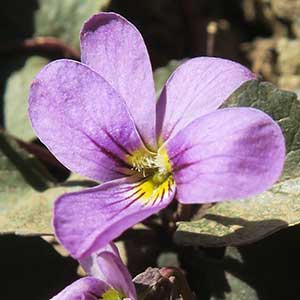Viola flettii
Viola macloskeyi
Flett's violet, Olympic violet, rock violet
Macloskey's or northern white or small white or smooth white or wild white violet, Macloskey's violet, northern white violet, small white violet, smooth white violet, violette pâle
1–3, ascending to erect, mostly glabrous, on caudex from fleshy rhizome.
basal and cauline;
basal: 1–3;
stipules linear-lanceolate, margins entire or with glandular processes, apex acuminate;
petiole 1.5–9.7 cm, mostly glabrous;
blade purple-tinted and –veined, broadly reniform to ovate, 0.9–2.4 × 1.2–4 cm, base cordate, margins finely crenate-serrate, eciliate, apex acute to obtuse, surfaces glabrous or sparsely pubescent along veins adaxially;
cauline similar to basal except: stipules ovate to lanceolate, margins entire or shallowly laciniate;
petiole 0.7–5.9 cm, usually glabrous;
blade 0.8–2.1 × 1.2–3.1 cm.
basal, 2–6, ascending to erect;
stipules ovate to linear-lanceolate, margins entire or glandular-toothed, apex acute;
petiole 1–10 cm, strigose;
blade unlobed, reniform to ovate, 1–6.5 × 1–5.5 cm, base broadly or shallowly cordate, margins ± entire or shallowly crenate, eciliate, apex rounded to acute, surfaces usually glabrous, abaxial surfaces sometimes puberulent on proximal 1/2.
1.8–7.1 cm, usually glabrous.
2.5–11(–21) cm, usually glabrous, sometimes villous.
sepals lanceolate, margins eciliate, auricles 0.5–1.5 mm;
petals soft reddish violet on both surfaces, all with yellow area basally, lower 3 dark violet-veined, lateral 2 bearded, lowest with white around yellow area, 10–15 mm, spur yellow, gibbous, 0.5–2 mm;
style head bearded; cleistogamous flowers axillary.
sepals lanceolate to ovate, margins eciliate, auricles 0.5–2 mm;
petals white on both surfaces, lower 3 purple-veined, lateral 2 bearded, rarely beardless, lowest 6–12 mm, spur white, gibbous, 1–2.5 mm;
style head beardless; cleistogamous flowers on ascending peduncles.
± spherical, 5–9 mm, glabrous.
ovoid, 5–9 mm, glabrous.
dark brown to brownish purple, 2.5–3 mm.
beige to bronze, 1–1.5 mm.
= 24.
Viola flettii
Viola macloskeyi
Viola flettii is endemic to the Olympic Mountains of northwestern Washington. C. S. McCreary (2005) noted that although morphologically and ecologically distinct, V. cuneata, V. flettii, and V. ocellata are closely related.
(Discussion copyrighted by Flora of North America; reprinted with permission.)
Viola macloskeyi was described by Banks in 1824 as V. rotundifolia var. pallens, from specimens collected by Banks in Labrador. E. Brainerd made the combination V. pallens in 1905 and later (1924) detailed its troublesome nomenclatural history.
Viola macloskeyi was described in 1895 by F. E. Lloyd based on specimens collected at the base of Mount Hood, Oregon. M. S. Baker (1953) placed V. macloskeyi as a subspecies of V. pallens. He later (1953b) corrected that change based on priority and thus the taxon became known as V. macloskeyi subsp. pallens. N. H. Russell (1955) maintained that status, separating subspp. macloskeyi and pallens on the wider, spreading basal leaf lobes of subsp. pallens. McKinney, after examining specimens of both taxa, including types, concluded that the differences have been exaggerated and fall within the range of variation of a single species.
Viola macloskeyi occurs in small colonies; individual plants are interconnected by stolons.
In parts of its range, Viola macloskeyi often shares habitat with V. renifolia; it may be difficult to distinguish the two. The stolons of V. macloskeyi are useful for identification during summer months; V. renifolia plants lack stolons. Patterns of indument can be useful; V. renifolia is usually hairy and V. macloskeyi is usually glabrous (petioles sometimes pubescent).
Viola macloskeyi reportedly hybridizes with V. primulifolia var. primulifolia (= V. ×mollicula House).
(Discussion copyrighted by Flora of North America; reprinted with permission.)
- Local floras:
BC,
CA,
OR,
WA
- Local Web sites:
CalFlora,
CalPhotos,
Flora NW,
IL Wildflowers,
MD Biodiversity,
MI Flora,
MN Wildflowers,
MO Plants,
PNW Herbaria,
SW CO Wildflowers,
Turner Photog.
WildflowerSearch
iNaturalist (observations)
USDA Plants Database
- LBJ Wildflower Center
- SEINet
- Plants of the World Online
- Encyclopedia of Life
- Wikipedia
- Google Image Search


